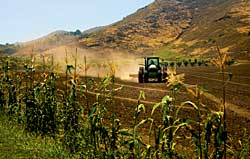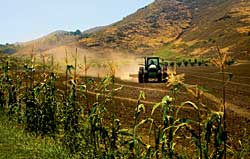
Remember, the Heat's On
Drinking water is a large defense against heat-related illnesses, but there are other steps that can be taken to protect workers.
- By Shel Segal
- Mar 01, 2007
 WITH the warm and humid summer months just around the corner, it is
important to remember what kind of illnesses and other heat-related
ailments can arise from being out in the heat too much.
WITH the warm and humid summer months just around the corner, it is
important to remember what kind of illnesses and other heat-related
ailments can arise from being out in the heat too much.
Jerry Bach, vice president of the Sacramento, Calif.-based Safety
Center, is an expert in trying to keep you safe during this time of the
year. Bach wants you to remember that when a crew of workers or an
individual works in a setting where heat can become a problem, this may
lead to heat exhaustion, heat stroke, or even death. You must know how
to take control of the situation and not be victimized.
"You need to recognize the symptoms of heat exhaustion and heat
stroke before they get out of control," Bach said. "Also, having enough
water on hand can prevent or counteract these situations."
Staying hydrated is the main factor in avoiding heat-related
illnesses. Four cups an hour is advised to enable the body to stave off
heat-related problems. In fact, somewhere in the vicinity of two
gallons of water a day is what is recommended by Bach for someone who
works in a heat "at risk" environment. "Water isn't the sole prevention
tool in fighting heat-related illnesses, but it sure is an important
one," he said. "It keeps the body cool and able to cope with hot and
humid situations, but only to a point."
If you work for a company that has its employees working in
heat-related situations, it must have policies and written procedures
to be followed. The policies and procedures should answer questions
such as:
- What do you do when it gets hot?
- How long can employees work in the heat before receiving a break?
- What should be done in the event of a medical emergency?
"Anyone who supervises a crew in the heat, whether it is a foreman
or the company president, needs to be completely up to speed with these
procedures," Bach said. "These individuals are responsible for their
workers' well-being. and they must make sure any and all policies and
procedures on the books are enforced."
Two Distinct Reactions to Heat
Don't be the hero when first starting to work in the heat, Bach
said. Make sure you take it slowly and gradually build up your
strength, endurance, and tolerance of the heat so your body gets used
to the warm environment. "It actually can take anywhere from four to 10
days for the body to get used to the warmer elements," he said.
There are two main heat-related illnesses: heat exhaustion and heat
stroke. Even though they are similarly named, they are two very
different reactions to heat, and it is necessary to know how to
recognize and treat each one.
The less dangerous of the two (but a menace nonetheless) is heat exhaustion.
Heat exhaustion is characterized by extreme sweating, pale face,
blurred vision, dizziness, headache, and fatigue. If someone is seen
with these symptoms, seek immediate emergency medical attention because
heat exhaustion can be fatal.
Even more serious than heat exhaustion is heat stroke.
Someone with heat stroke will most likely have hot, dry skin, can be
shivering and having convulsions, exhibit bouts of restlessness and
irritability, and can eventually collapse. Again, if someone is in this
condition, seek immediate emergency medical attention. Heat stroke is
often fatal.
"It doesn't matter: You don't want to suffer from either heat
exhaustion or heat stroke," Bach said. "They'll have you off the job
for some time, if they don't kill you first. We want you to be safe and
come to work and then go home to your loved ones. Heat exhaustion and
heat stroke won't let you do that. It is imperative that everyone
become familiar with the symptoms of these two conditions, know how to
treat them in the short term, and make sure proper medical attention is
sought."
Other Preventive Steps to Consider
An 80-degree day might seem like a good opportunity to go for a
walk and spend some time in the outdoors. However, for those working
outside, 80 degrees Fahrenheit becomes the point at where the
temperature becomes a concern for the workers. Needless to say,
reaching the 90-degree mark and above just heightens the concern for
the well-being of workers in regard to heat-related illnesses. For
someone wearing protective clothing, heat-related illnesses can become
a factor when the mercury is at just 70 degrees!
In addition, while humidity amplifies any heat-related problem,
being in direct sunlight can add up to 15 degrees on the heat index.
"What might seem like a nice day to go for a stroll or go outside
for a while can be very rough on workers in those same conditions,"
Bach said. "Working in direct sunlight makes any situation that much
more dangerous. Steps need to be taken to avoid turning a normal
workday into a medical, and possibly life-threatening, emergency."
While drinking water is a large defense against heat-related
illnesses, there are other steps that can be taken to protect workers.
One is just having enough shade available for workers to rest under and
cool off from the sun's direct rays. "The shade can come naturally,
either from a tree or from canopies that have been set up," said Bach.
Another provision that can be taken is having a misting machine on
hand that sprays water on the workers. The evaporation of that water
will naturally cool the workers' bodies and keep their body
temperatures down. One key thing here, Bach said, is to remember to
check that the misting machine works before it is hauled out to the
work site.
Supervisors also must give workers plenty of breaks and encourage
them to take advantage of the shade, misting machine, or other
provision taken to help fight the heat on a hot and humid summer day.
"Take breaks, drink water, and stay safe," Bach summarized. He said
still another tactic has been proven to keep workers safe, especially
those who work in the construction and agricultural industries.
"If it is possible, to keep workers safe, start shifts earlier in
the day, when it is very cool and comfortable, and end the shifts
earlier than traditionally done," Bach said. "This will allow the
workers to do the bulk of the work before it gets too hot and dangerous
and finish up before the heat of the day is at its peak."
Basics Elements of a Heat Stress Program
Heat-related problems such as heat exhaustion, heat stroke, and
even death can be minimized or even eradicated with the correct plan
and approach. Make sure employees drink plenty of water throughout the
day and take frequent breaks in a shaded area. If you provide a misting
machine, ensure they take advantage of that benefit, too.
Also, make sure they recognize the symptoms of heat exhaustion and
heat stroke, know the difference between them, and call for emergency
personnel if they suspect someone is suffering from one of these
ailments. And make sure your company has a plan or policies in place to
deal with the dangers of working in heated environments.
"Follow these steps, and you should remain safe throughout the
summer months when these illnesses traditionally rear their ugly
heads," Bach said.
This article appeared in the March 2007 issue of Occupational Health & Safety.
This article originally appeared in the March 2007 issue of Occupational Health & Safety.